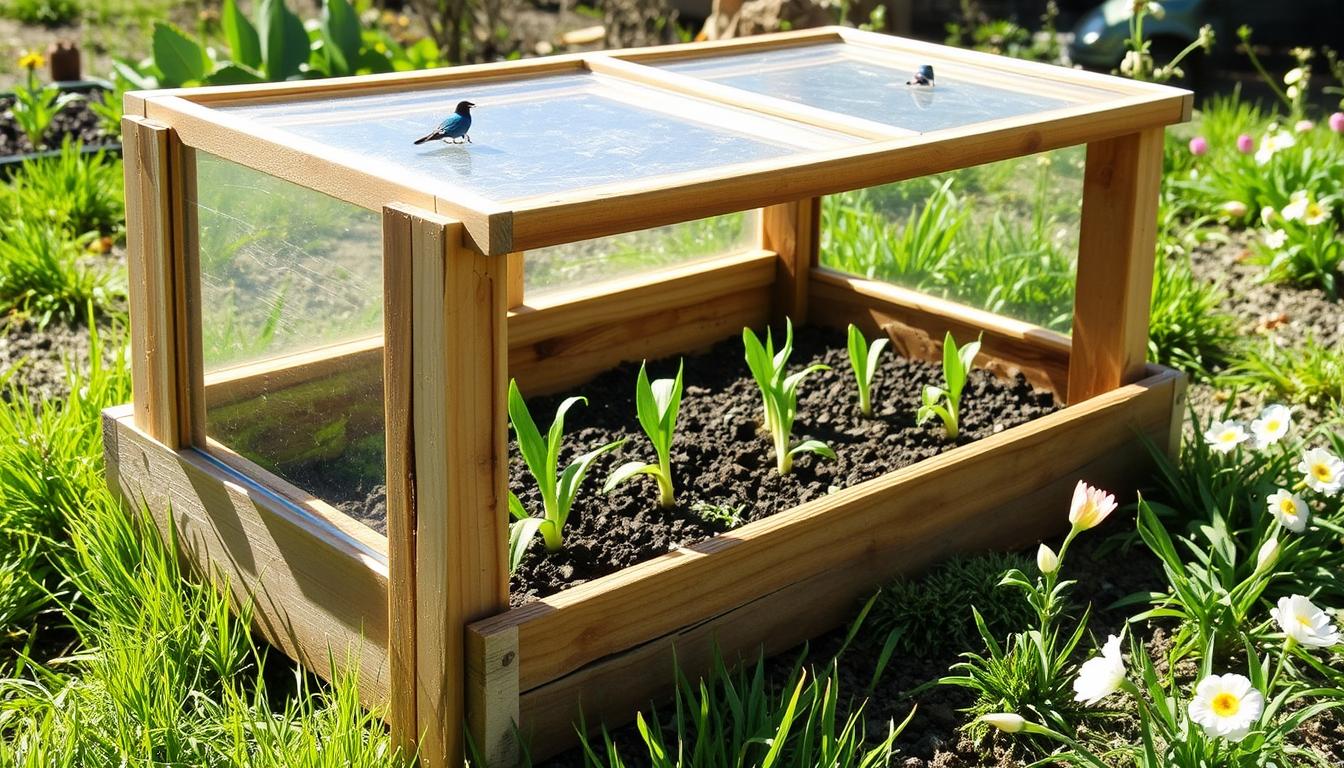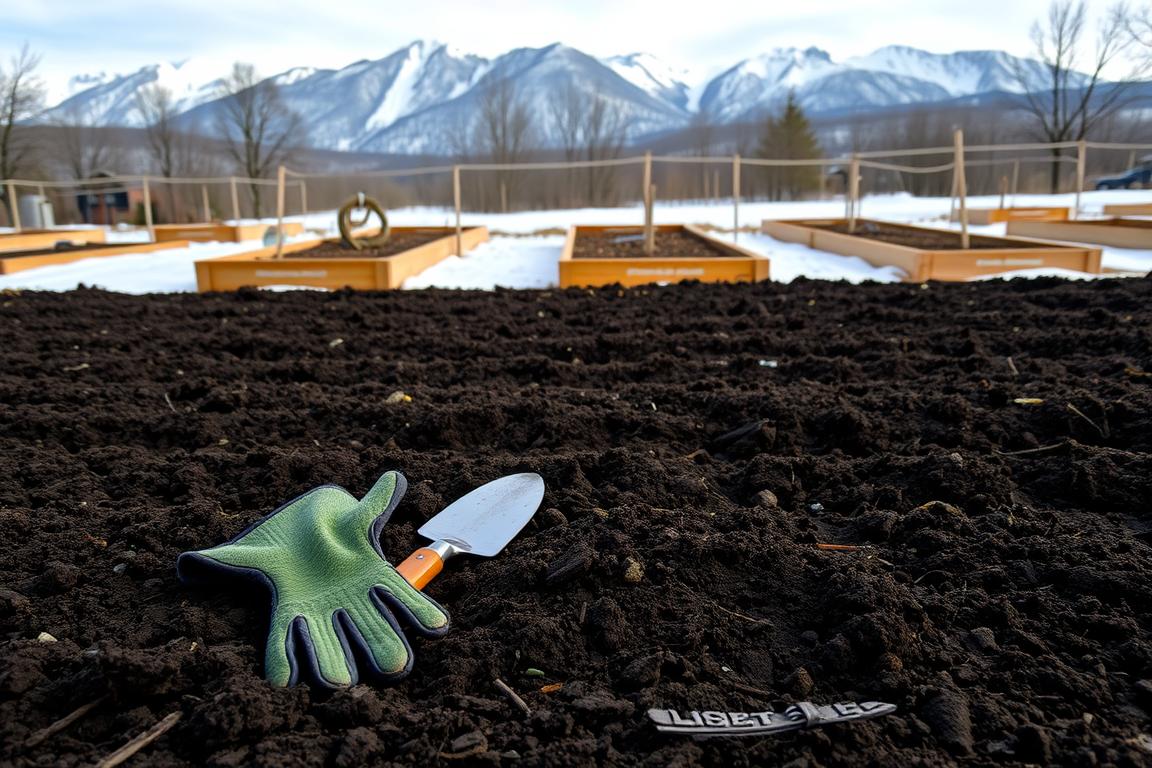As a gardener, I’m always searching for ways to extend the growing season. A cold frame is a key tool for this. These mini greenhouses protect plants from unpredictable early spring weather. They provide a cozy, sheltered space for plants to thrive.
Building your own cold frame is easy and affordable. It’s great for growing cold-hardy crops like lettuce and kale. It also helps start seedlings indoors before moving them outside. This way, you can protect plants from frost and extend the growing season.
Key Takeaways
- Cold frames are miniature greenhouses that extend the growing season by protecting plants from cold weather and frost
- They can be used in late fall to continue growing root vegetables, leafy greens, and herbs into early winter, and in early spring to get a head start on your planting
- Building your own cold frame is a simple and affordable project that can yield big results in your garden
- Cold frames offer frost protection for plants and act as a low-cost greenhouse alternative to help you extend the growing season
- They are a great tool for sustainable gardening techniques, seed starting indoors, and vegetable gardening tips
What is a Cold Frame?
A cold frame is a simple tool for gardening that helps extend the growing season. It’s like a mini greenhouse on the ground, protecting plants from cold and frost. It’s key for gardening in cold weather, letting gardeners start planting early in spring and keep growing into fall.
Definition and Purpose
The main job of a cold frame is to create a warm spot for plants. It keeps out harsh weather, trapping heat to keep plants cozy. This makes it perfect for starting seeds, getting seedlings ready for the outdoors, and growing cool-season crops longer.
Benefits of Cold Frames
- Extend the growing season by protecting plants from frost and cold winds
- Provide an inexpensive alternative to a full-size greenhouse
- Allow for earlier planting in the spring and later harvests in the fall
- Create a sheltered environment for hardening off seedlings
- Enable gardeners to grow a wider variety of cold-hardy crops
- Improve plant growth and yields through temperature regulation
Cold frames are a great asset for gardeners wanting to make the most of their growing season. They open up new ways to enjoy gardening all year long. By knowing how cold frames work, you can grow more and enjoy a garden full of life all season.
Planning Your Cold Frame
Before you start building a cold frame, think about a few important things. Decide if you need a cold frame that moves or one that stays in one place. Also, think about what you want to grow and where the best spot is for it.
Deciding on Mobility vs. Stationary
First, you need to choose between a mobile or stationary cold frame. Mobile cold frames are great for moving around to catch more sun. On the other hand, stationary cold frames work best in one spot, like a sunny corner.
Choosing Crops for Your Cold Frame
- For cold-hardy crops like lettuce and spinach, a simple cold frame is enough.
- For tender plants that need more protection, choose a sturdy, well-insulated cold frame.
Selecting the Best Location
Where you put your cold frame is very important. It should face south or southeast to get lots of sun. If that’s not possible, a flat cold frame works better and might need extra heat.
| Factors to Consider | Ideal Cold Frame Placement |
|---|---|
| Sun exposure | South or southeast facing |
| Slope | Flat design preferred over angled |
| Supplemental heat | May be needed if ideal sun exposure is not available |
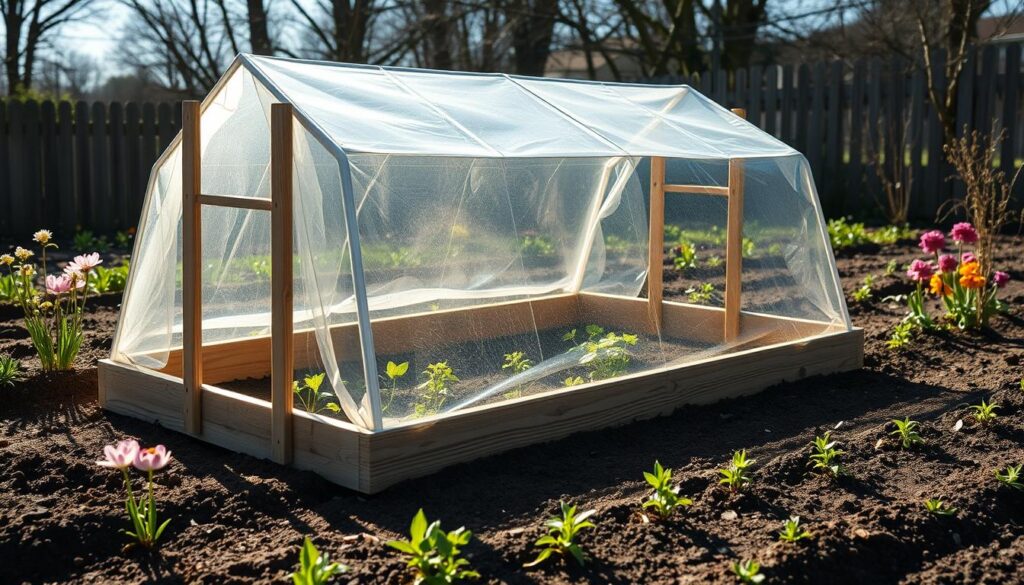
“Proper placement is key for a successful cold frame. Ideally, you want a south or southeast facing location to maximize sunlight exposure.”
Building Your Own Cold Frame for Early Spring Planting
Building a DIY cold frame is rewarding and saves money. You can use various materials and follow a simple guide. This way, you can protect your plants and create a perfect spot for early spring planting.
Materials Needed
Building a cold frame is affordable because you can use recycled materials. Here are the main things you’ll need:
- Wooden boards or planks for the frame (cedar, cypress, redwood or hemlock are durable options)
- A transparent lid, such as an old window, shower door or piece of plexiglass or clear plastic
- Hinges or a sliding mechanism for the lid
- Screws, nails or other fasteners
- Weatherproofing sealant (optional)
Step-by-Step Construction Guide
Here’s how to build your cold frame:
- Measure and cut the wooden boards to the desired size for your cold frame. A typical size is 3 to 4 feet wide by 6 to 8 feet long.
- Assemble the wooden frame, securing the boards together with screws or nails.
- Attach the transparent lid to the frame, using hinges or a sliding mechanism to allow for easy access and ventilation.
- Place the completed cold frame in the desired location, ensuring it’s level and facing the proper direction to maximize sun exposure.
- Optionally, apply a weatherproofing sealant to the wooden frame for added durability and protection.
With these materials and steps, you can build a sturdy, functional cold frame. It’s a great way to start your early spring planting. Get creative with your design using repurposed materials to fit your needs and space.
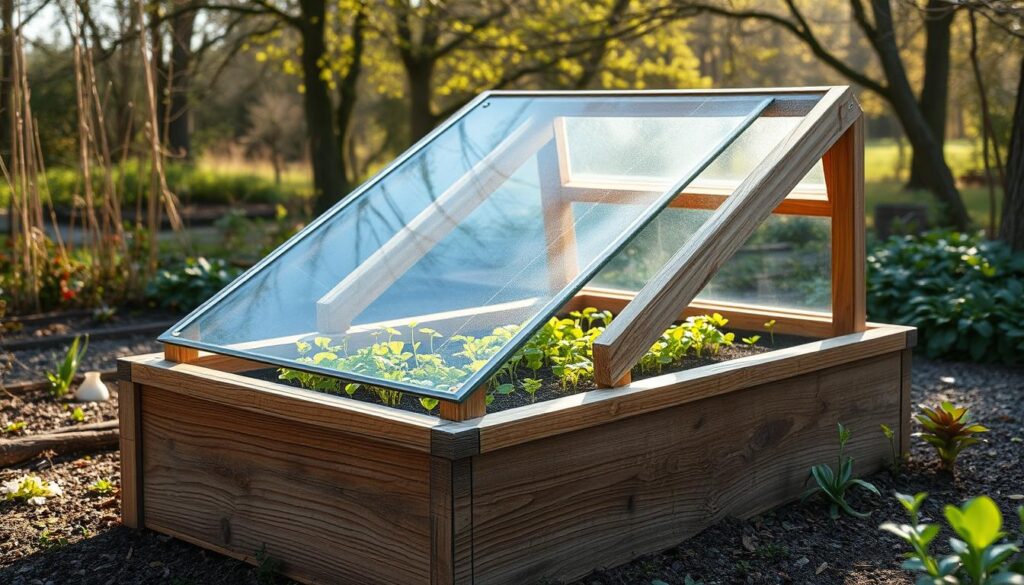
Insulating Your Cold Frame
Keeping the right temperature in your cold frame is key for your early spring plants. Even plants that can handle cold can’t survive below 26°F. So, it’s vital to insulate your cold frame well. There are many ways to keep your cold frame warm and ready for your plants to grow.
Importance of Proper Insulation
Without enough insulation for cold frames, they can get too cold too fast. This can harm or kill your plants. Good insulation keeps the inside around 75°F, perfect for plants to grow well. If you skip this, you might lose your crops.
Methods for Insulating Cold Frames
- Put bags of dry stuff like leaves or straw around the frame for extra insulation.
- Use weather stripping on the lid to seal it better and keep warmth in.
- Cover the glass or plastic with a thick blanket or canvas when it’s cold.
Insulating your cold frame well will help a lot. It keeps the perfect temperature for your spring plants. This way, you’ll get a great harvest.
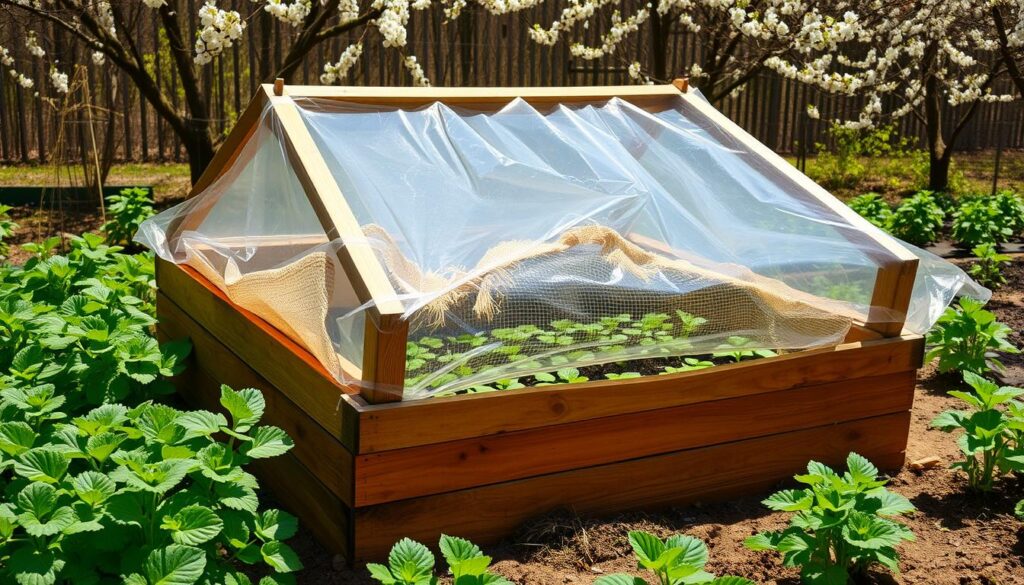
Temperature Regulation Techniques
Keeping the right temperature in a cold frame is key for your plants’ health and growth. A high-low thermometer is a great tool for watching temperature changes. It lets you adjust conditions for the best plant growth.
Using a High-Low Thermometer
A high-low thermometer tracks the highest and lowest temperatures over time. It’s perfect for monitoring cold frame temperature. By using it in your cold frame, you can see temperature changes and make smart choices about ventilation and cooling methods for cold frames.
Ventilation and Cooling Methods
If the cold frame gets too hot, you need to act fast. Opening the lid or adding vents helps ventilation techniques for cold frames. This lets hot air out and keeps the optimal cold frame temperature. On hot days, you might also need to shade the frame or use a fan to cool it down.
Learning how to control temperature is crucial for your plants. It helps them grow well and get a jumpstart on the growing season.
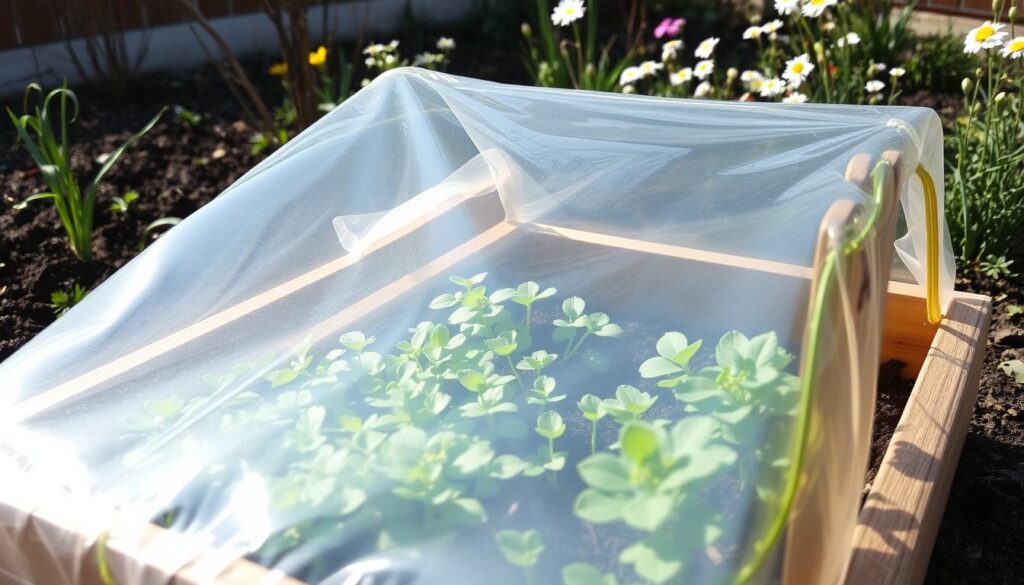
Planting in Your Cold Frame
Turning your cold frame into a garden is exciting. The first step is choosing the right cold-hardy crops to plant. When the ground is ready in early spring, usually in March, you can start planting seeds.
Choosing Cold-Hardy Crops
For best crops for cold frames, pick varieties that handle temperature changes well. Leafy greens like lettuce, spinach, and arugula are great choices. Also, root crops such as radishes, carrots, and beets do well. And don’t forget broccoli, kale, and cabbage – they love the cool, protected cold frame environment.
Sowing Seeds vs. Transplanting Seedlings
For the best results, direct sow your seeds in the cold frame. This method is better than transplanting seedlings. The temperature changes can harm young plants. So, sowing seeds directly in the cold frame is best for early spring planting in cold frames.
Keep an eye on the temperature and adjust your setup as needed. This will help your plants stay healthy and grow well.
“Proper temperature regulation is the key to success when planting in a cold frame. Stay vigilant and make adjustments as needed to ensure your crops thrive.”
Maintaining Your Cold Frame
Keeping your cold frame in good shape is crucial. It ensures it works well for years. A bit of care, like cleaning and soil nurturing, makes a big difference. It helps your plants grow better and extends your cold frame’s life.
Cleaning and Maintenance Tips
On mild spring days, clean the transparent lid of your cold frame. This removes dirt and lets more sunlight in. After the growing season, clean out any leftover plants or weeds. A clean cold frame is ready for future growth.
Amending Soil for Optimal Growth
- Replenish the soil with compost or aged manure between growing seasons to ensure optimal nutrient levels.
- Aerate the soil to improve drainage and oxygen circulation, which are crucial for healthy plant roots.
- Test the soil pH and make adjustments as needed to create the ideal growing environment for your chosen crops.
Proper maintenance and soil care lead to great harvests. Watch the temperature, airflow, and soil health closely. This way, your cold frame will serve you well for many seasons.
“Regular cleaning and maintenance is the key to keeping your cold frame functioning at its best.”
Conclusion
Cold frames are great for home gardeners to grow more food longer. They protect plants from harsh weather. This lets me start planting sooner and keep picking food later.
Choosing the right spot, insulating well, and keeping the right temperature and air are key. This makes a cold frame work well.
Building a cold frame is easy with some planning and DIY skills. It boosts my garden’s output. I can make a cold frame that will help my garden for years.
So, why not try making a cold frame? It’s a big step for my garden’s success. Let’s start and see the benefits for ourselves.
FAQ
Q: What is a cold frame and what is its purpose?
A: A cold frame is like a mini greenhouse on the ground. It protects plants from cold and frost. It helps harden off seedlings and start spring planting early. It also lets you grow crops later into fall.
Q: What are the main benefits of using a cold frame?
A: Using a cold frame has many benefits. It extends the growing season and protects plants from frost. It’s also cheaper than a full greenhouse. It helps gardeners start spring early and harvest longer into fall.
Q: What factors should I consider when planning my cold frame?
A: Before building a cold frame, think about how you’ll use it. Do you want a mobile or stationary frame? Choose a spot that faces south for best sunlight. Pick crops that grow fast and are cold-hardy for a basic frame.
Q: What materials can I use to construct a cold frame?
A: You can build a cold frame from wood, plastic, or concrete. A simple design is a wooden box with a clear lid. Use durable woods like cedar or hemlock for the sides.
Q: How do I properly insulate my cold frame?
A: Insulation keeps the temperature right for plants. Use dry materials like leaves or straw around the frame. Add weather stripping to the lid. Cover with a blanket or canvas in cold weather.
Q: How do I regulate the temperature inside my cold frame?
A: Keeping the right temperature is key for plants. Use a thermometer to check the temperature. Open the lid when it gets too hot. Close it when it gets cold. Good ventilation prevents heat buildup.
Q: What types of crops can I grow in a cold frame?
A: Start seeds in your cold frame in March in northern areas. Good choices include lettuce, spinach, and radishes. Broccoli, kale, and cabbage also do well.
Q: How do I maintain my cold frame for long-term use?
A: Keep your cold frame clean and well-maintained. Clean the lid and remove debris. Add compost or aged manure between seasons. Good airflow, temperature control, and soil health ensure long-term use.


